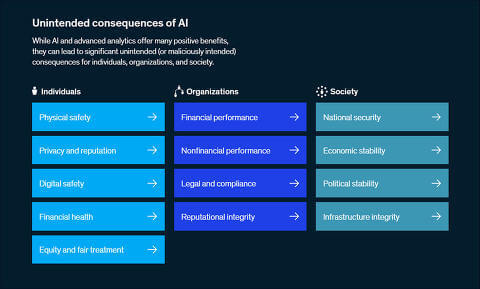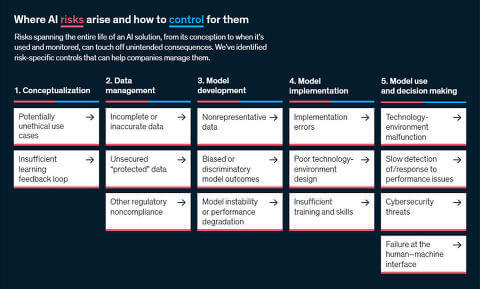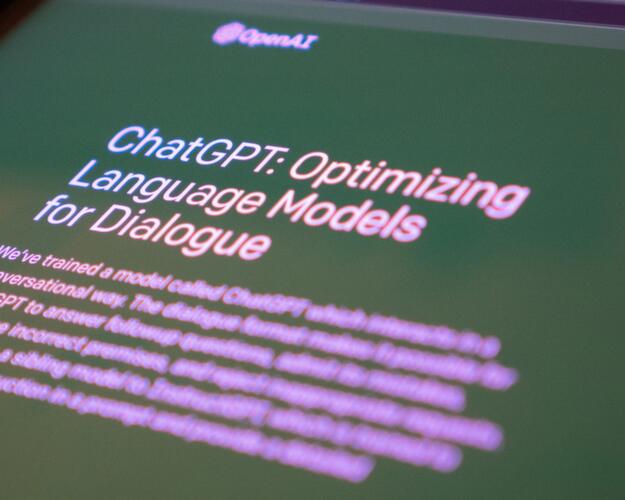AI risks, McKinsey
This month we look at McKinsey’s analysis of AI risks.

This month we look at McKinsey’s analysis of AI risks.
Theme of the report
The report looks at the direct risks that arise from building AIs, such as misdiagnosing a medical condition, or failing to spot that a machine is about to explode (but not problems arising from AI generally, such as a job losses).
This is highly relevant for the many enterprises trying to build their own AI’s in house.
A summary of the report: Structure, content, value
The report follows a logical structure: Introduction; What the risks are; How to identify the risks in your business.
The potential consequences of getting your AI wrong are discussed, including via an interactive image, with popup text highlighting consequence. Clear examples are given to bring the topic to life, such as:
- Autonomous-vehicle malfunction leads to injury or death
- Unintended discrimination embedded into lending decisions results in litigation
- Suboptimal estimates of funds required during emergencies results in inadequate preparation

Next, the specific risks that may cause these dangers are then identified: Collection and labelling of data, use of technology, data security, model mis-design, and integration with the wider business.
Finally, it looks at three core principles to mitigate these risks. In doing so it draws on practical examples of challenges faced by banks – rooting these abstract principles in real challenges.
The report presents a framework of how to start thinking about how to root them out. A final interactive graphic illustrates the risks that can arise at each stage of the AI development lifecycle, helping plan the process of risk identification.

Finally, McKinsey does a great job of presentation. Although the content offers depth it is easy to read. It is in a nice font, well-spaced, shortish paragraphs and lots of clear signposting.
How does McKinsey’s AI content compare to its competitors?
It is interesting to contrast McKinsey’s approach to other consulting giants who communicate based primarily on their insights. Accenture’s Explainable AI report also hits on an interesting theme, but doesn’t quite measure up.
It’s spends too long introducing the subject and speculating on broad trends. It is interesting, and its two use cases are strong. But the advice is generic, not actionable, and it doesn’t leave you feeling you have understood the issue and, critically, what you can do about it. It just doesn’t feel differentiated from all the other AI advice out there. McKinsey’s does.
Does this make McKinsey better? Who knows? But the grounded explanations and insights leaves the impression they have been through this process, whereas Accenture’s feels like they are trying to establish a position.
How do they use the content, and how can I replicate this?
McKinsey and Accenture likely take out ads in the Economist and other major business publications for these reports, as well as running targeted online campaigns, and pushing them heavily at events.

For those with more modest budgets, such a report can still reach customers through targeting via LinkedIn and search advertising, trade publications, and trade events.
It is worth noting that complex industry focussed topics like this – which offer practical advice to those who might spend big money on solutions – rarely seem to hit home with the media. Most journalists simply don’t have the time or experience to understand complex issues like this, which is part of the reason the more insightful companies are building up their own channels – some of which are becoming much better sources of industry insight than the media (see our article on the changing value of PR).
Conclusions and takeaways
- Root your content in your customers’ specific challenges. They already know what the trends are – these pieces need to move them forward as a business. Good content offers a practical path to deploy new ideas or technologies. Knowing something might disrupt your business is of only modest value, decision makers want to know how to harness it.
- Design and layout matter: no matter how good the content, text which is easy to read on a screen will have a much higher chance of being read.
- Remember your audience. You are not writing for the media, where you have to appeal to the least informed reader. You are writing for a relatively small number of high-value, well-informed potential customers. You don’t need to make the content sexy, you need to offer value.
For more insights like this, sign up to our newsletter.









